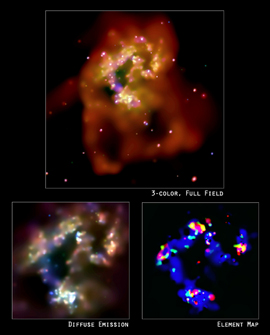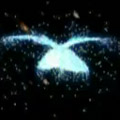January 07, 2004
NASA RELEASE: 04-013
NASA's Chandra X-ray Observatory has discovered rich deposits of neon, magnesium, and silicon in a pair of colliding galaxies known as The Antennae. When the clouds in which these elements are present cool, an exceptionally high number of stars with planets should form. These results may foreshadow the fate of the Milky Way and its future collision with the Andromeda Galaxy.
"The amount of enrichment of elements in The Antennae is phenomenal," said Giuseppina Fabbiano of the Harvard-Smithsonian Center for Astrophysics (CfA) in Cambridge, Mass. at a press conference at a meeting of the American Astronomical Society in Atlanta, Ga. "This must be due to a very high rate of supernova explosions in these colliding galaxies." Fabbiano is lead author of a paper on this discovery by a team of U.S. and U.K. scientists that will appear in an upcoming issue of The Astrophysical Journal Letters.
When galaxies collide, direct hits between stars are extremely rare, but collisions between huge gas clouds in the galaxies can trigger a stellar baby boom. The most massive of these stars race through their evolution in a few million years and explode as supernovas. Heavy elements manufactured inside these stars are blown away by the explosions and enrich the surrounding gas for thousands of light years.
"The amount of heavy elements supports earlier studies that indicate there was a very high rate of relatively recent supernovas, 30 times that of the Milky Way," according to collaborator Andreas Zezas of the CfA.
The supernova violence also heats the gas to millions of degrees Celsius. This makes much of the matter in the clouds invisible to optical telescopes, but it can be observed by an X-ray telescope. Chandra data revealed for the first time regions of varying enrichment in the galaxies – in one cloud magnesium and silicon are 16 and 24 times as abundant as in the Sun.
"These are the kinds of elements that form the ultimate building blocks for habitable planets," said Andrew King of the University of Leicester, U.K. and a coauthor of the study. "This process occurs in all galaxies, but it is greatly enhanced by the collision. Usually we only see the new elements in diluted form as they are mixed up with the rest of the interstellar gas."
CfA coauthor Alessandro Baldi commented that, "This is spectacular confirmation of the idea that the basis of chemistry, of planets, and ultimately of life is assembled inside stars and spread through galaxies by supernova explosions,"
As the enriched gas cools, a new generation of stars will form, and with them new planets. A number of studies indicate that clouds enriched in heavy elements are more likely to form stars with planetary systems, so in the future an unusually high number of planets may form in The Antennae.
"If life arises on a significant fraction of these planets, then in the future the Antennae will be teeming with life," speculated Francois Schweizer, another coauthor who is from the Carnegie Observatories in Pasadena, Calif. "A vast number of Sun like stars and planetary systems will age in unison for billions of years."
At a distance of about 60 million light years, The Antennae system is the nearest example of a collision between two large galaxies. The collision, which began a couple of hundred million years ago, has been so violent that gas and stars from the galaxies have been ejected into the two long arcs that give the system its name. The Chandra image shows spectacular loops of 3-million-degree gas spreading out south of the antennae. "These loops may be carrying out some of the elements dispersed by supernovas into intergalactic space," said Trevor Ponman of Birmingham University, U.K.
The Antennae give a closeup view of the type of collisions that were common in the early universe and likely led to the formation of most of the stars that exist in the universe today. They may also provide a glimpse of the future of our Milky Way Galaxy, which is on a collision course with the Andromeda Galaxy. At the present rate, a crash such as the one now occurring in the Antennae could happen in about 3 billion years. Tremendous gravitational forces will disrupt both galaxies and reform them, probably as a giant elliptical galaxy with hundreds of millions of young Sun like stars, and possibly planetary systems.
NASA's Marshall Space Flight Center, Huntsville, Ala., manages the Chandra program for the Office of Space Science, NASA Headquarters, Washington. Northrop Grumman of Redondo Beach, Calif., formerly TRW, Inc., was the prime development contractor for the observatory. The Smithsonian Astrophysical Observatory controls science and flight operations from the Chandra X-ray Center in Cambridge, Mass.
Additional information and images are available at:
MEDIA CONTACTS
Don Savage
NASA Headquarters, Washington, DC
Phone: 202-358-1727
Steve Roy
Marshall Space Flight Center, Huntsville, AL
Phone: 256-544-6535
Megan Watzke
Chandra X-ray Observatory Center, CFA, Cambridge, MA
Phone: 617-496-7998
cxcpress@cfa.harvard.edu




